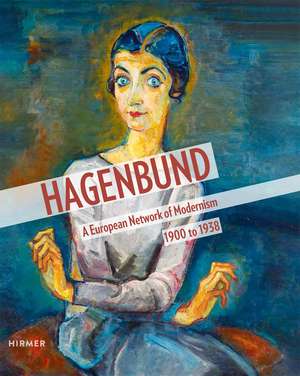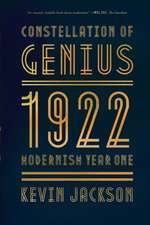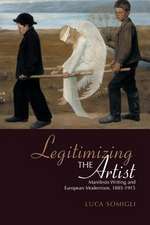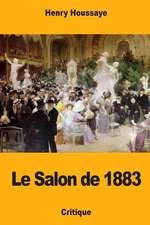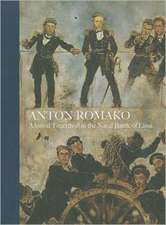Hagenbund: A European Network of Modernism 1900 to 1938
Editat de Agnes Husslein-Arcoen Limba Engleză Hardback – 28 apr 2016
The
Viennese
artists’
association
Hagenbund
played
a
crucial
role
in
the
artistic
scene
of
not
only
Vienna
but
of
Central
Europe
in
general.
Active
from
1900
to
1938,
the
group
united
several
different
art
movements
under
its
umbrella
and
helped
to
introduce
a
new
creative
dynamic
at
a
time
when
the
Vienna
Secession
was
slowly
losing
its
impact.
In
that
context,
the
liberal
political
and
artistic
attitude
of
the
Hagenbund
membership
was
revolutionary.
The
Hagenbund
counted
more
than
250
members,
among
them
Georg
Merkel,
Oskar
Laske,
Carry
Hauser,
Otto
Rudolf
Schatz,
Emil
Strecker,
and
Fritz
Schwarz-Waldegg.
This volume traces the history of the Hagenbund and its influence, offering the first sustained analysis of the group in an art-historical context. Packed with more than three hundred color images, it will be the standard work on the Hagenbund for decades to come.
This volume traces the history of the Hagenbund and its influence, offering the first sustained analysis of the group in an art-historical context. Packed with more than three hundred color images, it will be the standard work on the Hagenbund for decades to come.
Preț: 269.26 lei
Preț vechi: 429.93 lei
-37%
Puncte Express: 404
Preț estimativ în valută:
47.64€ • 55.38$ • 41.29£
47.64€ • 55.38$ • 41.29£
Carte disponibilă
Livrare economică 11-25 februarie
Preluare comenzi: 021 569.72.76
Specificații
ISBN-13: 9783777422749
ISBN-10: 3777422746
Pagini: 448
Ilustrații: 462 color plates and halftones
Dimensiuni: 240 x 291 x 42 mm
Greutate: 2.4 kg
Editura: Hirmer Publishers
Colecția Hirmer Publishers
ISBN-10: 3777422746
Pagini: 448
Ilustrații: 462 color plates and halftones
Dimensiuni: 240 x 291 x 42 mm
Greutate: 2.4 kg
Editura: Hirmer Publishers
Colecția Hirmer Publishers
Notă biografică
Agnes
Husslein-Arcois
an
art
historian
and
director
of
the
Belvedere
Gallery
in
Vienna.
Cuprins
Foreword
Agnes Husselein-Arco
“Promotion of Patriotic Artistic Efforts”
The Hagenbund and the Art Policy Framework from the Monarchy to the Chancellor Dictatorship
Oliver Rathkolb
Intrinsic Dynamics and Extrinsic Influences. The Artists Network Hagenbund
Harald Krejci
AROUND 1908. BEGINNINGS, KAISER-HULDIGUNGS-AUSSTELLUNG
The Hagenbund as Showcase for Central European Modernism in the 1920s and 1930s
Cornelia Cabuk
Pragmatic Modernism. Between Avant-garde and Mainstream. Architectural Practice in the Hagenbund
Matthias Boeckl
AROUND 1912. EXPRESSIONISM AND THE NEUKUNSTGRUPPE
Between Image Building and Pragmatism: On the Hagenbund’s Exhibition Policy
Verena Gamper
Structure, Network, Discourse. Anatomy of an Artists Association
Maximilian Kaiser
Exhibition-Chronology 1899—1938
AROUND 1920. TENDENCIES OF POST-WAR EXPRESSIONISM
Artists Associations in Exchange. Czech Art in the Hagenbund
Vojtech Lahoda
An Undervalued Place of often Unwelcome Painters. Polish Art in the Hagenbund
Dorota Kudelska
Hungarians in the Hagenbund, the Hagenbund in Hungary
Éva Bajkay
AROUND 1925. GIVING FORM AN ACTUAL SHAPE. VARIETIES OF OBJECTIVITY.
Art in the Service of Power
The Cultural Policy of Austrofascism 1934 to 1938 and the Dissolution of the Hagenbund
Elisabeth Klamper
“Extraordinary” Women in the Hagenbund. Female Artists and their Networks
Kerstin Jesse
UNTIL 1934. COSMOPOLITANISM AND SOCIAL CRITICISM
“Miscellaneous”: The Public Sphere and the Hagenbund’s Political and Social Commitment
Axel Köhne
Four Decades of Migration. The Hagenbund and its Artists
Károly Kókai
UNTIL 1938. INNER EMIGRATION AND EXILE.
The Modern Galerie and the Hagenbund
Kerstin Jesse
Appendix
Biograms ~Verena Gamper, Maximilian Kaiser
Guests of the Hagenbund
List of reviewers
Authors Biographies
Abbreviations
Picture credits
Colophon
Agnes Husselein-Arco
“Promotion of Patriotic Artistic Efforts”
The Hagenbund and the Art Policy Framework from the Monarchy to the Chancellor Dictatorship
Oliver Rathkolb
Intrinsic Dynamics and Extrinsic Influences. The Artists Network Hagenbund
Harald Krejci
AROUND 1908. BEGINNINGS, KAISER-HULDIGUNGS-AUSSTELLUNG
The Hagenbund as Showcase for Central European Modernism in the 1920s and 1930s
Cornelia Cabuk
Pragmatic Modernism. Between Avant-garde and Mainstream. Architectural Practice in the Hagenbund
Matthias Boeckl
AROUND 1912. EXPRESSIONISM AND THE NEUKUNSTGRUPPE
Between Image Building and Pragmatism: On the Hagenbund’s Exhibition Policy
Verena Gamper
Structure, Network, Discourse. Anatomy of an Artists Association
Maximilian Kaiser
Exhibition-Chronology 1899—1938
AROUND 1920. TENDENCIES OF POST-WAR EXPRESSIONISM
Artists Associations in Exchange. Czech Art in the Hagenbund
Vojtech Lahoda
An Undervalued Place of often Unwelcome Painters. Polish Art in the Hagenbund
Dorota Kudelska
Hungarians in the Hagenbund, the Hagenbund in Hungary
Éva Bajkay
AROUND 1925. GIVING FORM AN ACTUAL SHAPE. VARIETIES OF OBJECTIVITY.
Art in the Service of Power
The Cultural Policy of Austrofascism 1934 to 1938 and the Dissolution of the Hagenbund
Elisabeth Klamper
“Extraordinary” Women in the Hagenbund. Female Artists and their Networks
Kerstin Jesse
UNTIL 1934. COSMOPOLITANISM AND SOCIAL CRITICISM
“Miscellaneous”: The Public Sphere and the Hagenbund’s Political and Social Commitment
Axel Köhne
Four Decades of Migration. The Hagenbund and its Artists
Károly Kókai
UNTIL 1938. INNER EMIGRATION AND EXILE.
The Modern Galerie and the Hagenbund
Kerstin Jesse
Appendix
Biograms ~Verena Gamper, Maximilian Kaiser
Guests of the Hagenbund
List of reviewers
Authors Biographies
Abbreviations
Picture credits
Colophon
Recenzii
“While
there
is
an
abundance
of
scholarship
focused
on
the
Vienna
Secession,
there
is
far
less
written
about
the
Hagenbund,
the
other
major
Viennese
modernist
artists'
organization
of
the
early
twentieth
century.
.
.
.
ThusHagenbund:
A
European
Network
of
Modernism
1900–1938is
an
important
contribution.
.
.
.
The
catalog
is
richly
illustrated
with
reproductions
of
paintings,
sculpture,
and
graphic
work,
.
.
.
and
it
will
be
of
value
to
any
institution
that
collects
books
on
this
period.”
Descriere
The Viennese artists association Hagenbund played a crucial role in the artistic scene of not only Vienna but of Central Europe in general. Active from 1900 to 1938, the group united several different art movements under its umbrella and helped to introduce a new creative dynamic at a time when the Vienna Secession was slowly losing its impact. In that context, the liberal political and artistic attitude of the Hagenbund membership was revolutionary. The Hagenbund counted more than 250 members, among them Georg Merkel, Oskar Laske, Carry Hauser, Otto Rudolf Schatz, Emil Strecker, and Fritz Schwarz-Waldegg. This volume traces the history of the Hagenbund and its influence, offering the first sustained analysis of the group in an art-historical context. Packed with more than three hundred color images, it will be the standard work on the Hagenbund for decades to come."
